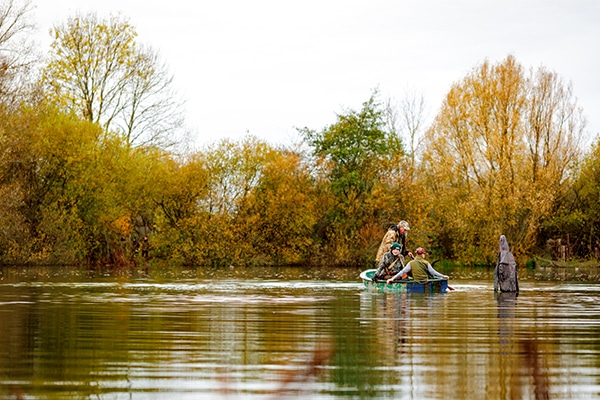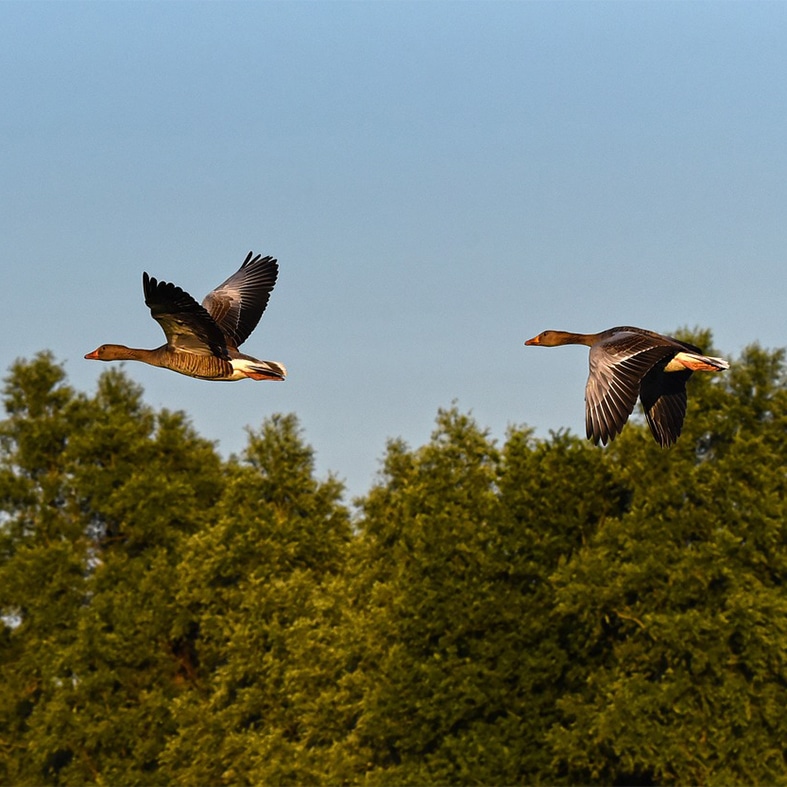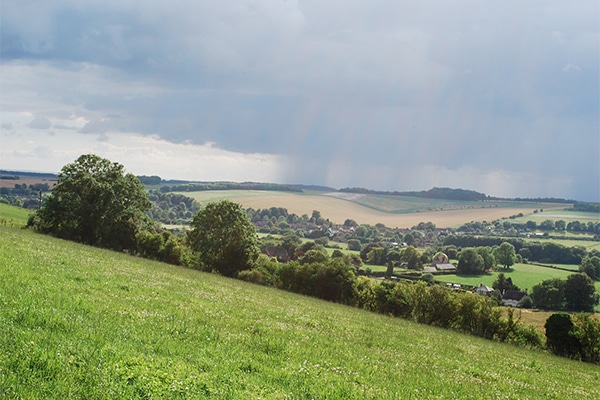
Wildfowling permits
Whether you are completely new to wildfowling or just fancy trying it in a new destination, did you know you can enjoy a day for as little as £8?
Get information on the legal shooting season for mammals and birds in the UK.
Learn about our current conservation projects and how you can get involved.
Comprehensive information and advice from our specialist firearms team.
Everything you need to know about shotgun, rifle and airgun ammunition.
Find our up-to-date information, advice and links to government resources.
Everything you need to know on firearms law and licensing.
All the latest news and advice on general licences and how they affect you.


Wildfowling What can I shoot?
Notes: 1 – Northern Ireland only,
2 – England, Wales and Scotland only,
3- As of 01/04/2020 Greenland white-fronted geese have been removed from quarry list.
It is the responsibility of the shooter to ensure they can identify their quarry.
As there is no way of identifying the difference between Greenland white-fronted and European white-fronted geese when in flight, we would recommend wildfowlers continue to honour the moratorium in the north of England to ensure they remain legal.
For more details, contact the wildfowling team.
England, Wales and Scotland: 1 September – 31 January (above high-water mark of ordinary spring tides).
England, Wales and Scotland: 1 September – 20 February (below high-water mark of ordinary spring tides).
Note that duck and goose species only (no waders) can be shot after 31 January when below the high-water mark of ordinary spring tides.
Northern Ireland: 1 September – 31 January.
Further advice on this can be obtained from wildfowling clubs in the area, BASC head office and country and regional offices.
Isle of Man: *Geese can only be shot under general licence, under the Wildlife Act 1990
| Species | England and Wales | Scotland | Northern Ireland | Isle of Man |
| Duck and goose inland | Sep 1 – Jan 31 | Sep 1 – Jan 31 | Sep 1 – Jan 31 | Ducks – Sep 1 – Jan 31 Geese July 1 – Mar 31 |
| Duck and goose below HOST | Sep 1 – Feb 20 | Sep 1 – Feb 20 | Sep 1 – Jan 31 | Ducks Sep 1 – Jan 31 Geese July 1 – Mar 31 |
| Common snipe | Aug 12 – Jan 31 | Aug 12 – Jan 31 | Sep 1 – Jan 31 | Sep 1 – Jan 31 |
| Jack snipe | Protected | Protected | Sep 1 – Jan 31 | Protected |
| Woodcock | Oct 1 – Jan 31 | Sep 1 – Jan 31 | Oct 1 – Jan 31 | Oct 1 – Jan 31 |
| Golden plover | Sep 1 – Jan 31 | Sep 1 – Jan 31 | Sep 1 – Jan 31 | Protected |
| Coot/moorhen | Sep 1 – Jan 31 | Sep 1 – Jan 31 | Protected | Protected |

Whether you are completely new to wildfowling or just fancy trying it in a new destination, did you know you can enjoy a day for as little as £8?

BASC-affiliated wildfowling clubs manage sporting rights on approximately 700km of foreshore owned by The Crown Estate in England, Wales and Northern Ireland.

Biosecurity refers to all the measures taken to minimise the risk of infectious diseases caused by viruses, bacteria or other microorganisms entering, emerging, establishing or spreading as a result of our actions.
Sign up to our weekly newsletter and get all the latest updates straight to your inbox.
© 2023 British Association for Shooting and Conservation. Registered Office: Marford Mill, Rossett, Wrexham, LL12 0HL – Registered Society No: 28488R. BASC is a trading name of the British Association for Shooting and Conservation Limited which is authorised and regulated by the Financial Conduct Authority (FCA) under firm reference number 311937.
If you have any questions or complaints about your BASC membership insurance cover, please email us. More information about resolving complaints can be found on the FCA website or on the EU ODR platform.

Black with white flanks and belly; rounded head and drooping crest.

Rich dark brown head and back; flanks and underside paler; crest shorter than male.
In flight both sexes appear black with white belly and a distinctive broad white wing bar. Juvenile resembles female.
Size: 46–56cm (18–22in)
Small, compact diving duck.
England and Wales: 1 Sept – 31 Jan
Scotland: 1 Sept – 31 Jan
Northern Ireland: 1 Sept – 31 Jan
Isle of Man: 1 Sept – 31 Jan
England and Wales: Sep 1 – Feb 20
Scotland: Sep 1 – Feb 20
Northern Ireland: Sep 1 – Jan 31
Isle of Man: Sep 1 – Jan 31
*HOST – Height of an Ordinary Spring Tide
England, Wales and Scotland: Any area below high-water mark of ordinary spring tides.
* The sale of Gadwall is prohibited by the WCA1981.

High-crowned, ‘triangular’ dark head and short bill, with greenish-purple gloss and circular white patch on cheek; neck and under parts white contrasting with black back and rump and grey tail; white inner wing readily seen in flight.

Smaller than male; has chocolate-brown head, pale blue-grey upper parts with white under parts, grey flanks and tail; wings dark with conspicuous white patch similar to male.
Size: 42–50cm (17–20in)
Medium-sized, stocky sea duck.
In Wales the Greenland white-front is subject to a voluntary no shooting moratorium initiative because of its declining population. The following description relates to the European white-fronted goose.
Medium-sized grey-brown goose characterised by white band at base of upper bill and black bars on belly. Amount of black on underside very variable.
Young birds lack these characteristics but are normally found among adults. Generally dark greyish-brown plumage, fairly long pink bill, orange legs.
England and Wales: 1 Sept – 31 Jan
Scotland: 1 Sept – 31 Jan
Northern Ireland: 1 Sept – 31 Jan
Isle of Man: 1 Sept – 31 Jan
England and Wales: Sep 1 – Feb 20
Scotland: Sep 1 – Feb 20
Northern Ireland: Sep 1 – Jan 31
Isle of Man: Sep 1 – Jan 31
*HOST – Height of an Ordinary Spring Tide
England, Wales and Scotland: Any area below high-water mark of ordinary spring tides.


Large, heavily built dabbling duck with rather long head and bill.
Size: 50–65cm (20–26in)
England and Wales: 1 Sept – 31 Jan
Scotland: 1 Sept – 31 Jan
Northern Ireland: 1 Sept – 31 Jan
Isle of Man: 1 Sept – 31 Jan
England and Wales: Sep 1 – Feb 20
Scotland: Sep 1 – Feb 20
Northern Ireland: Sep 1 – Jan 31
Isle of Man: Sep 1 – Jan 31
*HOST – Height of an Ordinary Spring Tide
England, Wales and Scotland: Any area below high-water mark of ordinary spring tides.


Dark brown head, and back of neck, pure white breast, sides and front of neck, extending as white streak up side of head; under parts white; back and flanks light grey; rump black; wings grey and brown with green speculum conspicuous in flight.


Duller, grey-brown plumage and no discernible wing pattern in flight, except a light trailing edge to inner wing.
Juvenile resembles female, but generally darker and more uniform.
Size: 51–66 cm (20–26in)
Large slim dabbling duck with long neck and long narrow tail.
England and Wales: 1 Sept – 31 Jan
Scotland: 1 Sept – 31 Jan
Northern Ireland: 1 Sept – 31 Jan
Isle of Man: 1 Sept – 31 Jan
England and Wales: Sep 1 – Feb 20
Scotland: Sep 1 – Feb 20
Northern Ireland: Sep 1 – Jan 31
Isle of Man: Sep 1 – Jan 31
*HOST – Height of an Ordinary Spring Tide
England, Wales and Scotland: Any area below high-water mark of ordinary spring tides.

Dark chestnut head and neck contrasting with pale grey back and flanks, black breast and tail.

Uniform dull brown, slightly paler around face.
Both sexes characterised in flight by absence of white on wings; forewing dark grey. Juvenile resembles female.
Size: 42–49cm (17–19in)
Medium-sized diving duck with short-necked, ‘dumpy’ appearance on water, and long broad bill.
England and Wales: 1 Sept – 31 Jan
Scotland: 1 Sept – 31 Jan
Northern Ireland: 1 Sept – 31 Jan
Isle of Man: 1 Sept – 31 Jan
England and Wales: Sep 1 – Feb 20
Scotland: Sep 1 – Feb 20
Northern Ireland: Sep 1 – Jan 31
Isle of Man: Sep 1 – Jan 31
*HOST – Height of an Ordinary Spring Tide
England, Wales and Scotland: Any area below high-water mark of ordinary spring tides.


Striking dark green head, chestnut flanks and belly contrasting with pure white chest, pale blue forewing, green speculum edged with white.


Mottled brown, with similar but duller blue forewing and green speculum.
Juvenile a dull version of female.
Size: 44–52cm (17–20 in)
Medium-sized dabbling duck; both sexes characterised by very large, spoon-like bill, large flattened head and short neck.
England and Wales: 1 Sept – 31 Jan
Scotland: 1 Sept – 31 Jan
Northern Ireland: 1 Sept – 31 Jan
Isle of Man: 1 Sept – 31 Jan
England and Wales: Sep 1 – Feb 20
Scotland: Sep 1 – Feb 20
Northern Ireland: Sep 1 – Jan 31
Isle of Man: Sep 1 – Jan 31
*HOST – Height of an Ordinary Spring Tide
England, Wales and Scotland: Any area below high-water mark of ordinary spring tides.

Black heads, shoulder and breast, with white flanks, grey back and a black tail.

Predominantly brown with white patches around the base of the bill. In flight they show white patches along the length of the trailing edge of the wing.
Size: 42-51cm (16.5-20in)
Diving ducks with a strong resemblance to tufted ducks.
Northern Ireland only 1 Sep – 31 Jan
England and Wales: N/A
Scotland: N/A
Northern Ireland: 1 Sept – 31 Jan
Isle of Man: N/A
England and Wales: N/A
Scotland: N/A
Northern Ireland: Sep 1 – Jan 31
Isle of Man: N/A
*HOST – Height of an Ordinary Spring Tide
England, Wales and Scotland: Any area below high-water mark of ordinary spring tides.

Characterised by conspicuous grey plumage contrasting with dark chestnut head, creamy-buff patch on each side of black under-tail feathers and prominent white stripe along shoulders; breast cream coloured, spotted with black; underside white.

Mottled brown with paler cheeks and whitish underside.
Size: 34–38cm (13–15in)
Small, compact dabbling duck with narrow pointed wings.
Juvenile similar to female with spotted under parts.
England and Wales: 1 Sept – 31 Jan
Scotland: 1 Sept – 31 Jan
Northern Ireland: 1 Sept – 31 Jan
Isle of Man: 1 Sept – 31 Jan
England and Wales: Sep 1 – Feb 20
Scotland: Sep 1 – Feb 20
Northern Ireland: Sep 1 – Jan 31
Isle of Man: Sep 1 – Jan 31
*HOST – Height of an Ordinary Spring Tide
England, Wales and Scotland: Any area below high-water mark of ordinary spring tides.


Black with white flanks and a long tuft at the back of the head.


Entirely chocolate brown except for a white area on the belly.
Size: 40-47cm (15-18.5in)
A medium-sized diving duck that is just smaller than the mallard and chunkier than a wigeon .
Both with a visible tuft on the top of their heads that provides the basis of their name, they have pale blue bills with black tip and yellow eyes and when in flight both show an obvious white stripe across the back of their wing.
England and Wales: 1 Sept – 31 Jan
Scotland: 1 Sept – 31 Jan
Northern Ireland: 1 Sept – 31 Jan
Isle of Man: 1 Sept – 31 Jan
England and Wales: Sep 1 – Feb 20
Scotland: Sep 1 – Feb 20
Northern Ireland: Sep 1 – Jan 31
Isle of Man: Sep 1 – Jan 31
*HOST – Height of an Ordinary Spring Tide
England, Wales and Scotland: Any area below high-water mark of ordinary spring tides.

Duller; brown plumage tinged rufous, white underside, green speculum fringed with white wing bars. Short bill and dark, pointed tail useful identifying characters.

Mainly grey with buff forehead and crown, chestnut head, chest pinkish brown, white under parts; white shoulder patch readily seen in flight.
Size: 45–51cm (18–20in)
Medium-sized, short-necked, compact dabbling duck with small bill, pointed tail and narrow wings.
England and Wales: 1 Sept – 31 Jan
Scotland: 1 Sept – 31 Jan
Northern Ireland: 1 Sept – 31 Jan
Isle of Man: 1 Sept – 31 Jan
England and Wales: Sep 1 – Feb 20
Scotland: Sep 1 – Feb 20
Northern Ireland: Sep 1 – Jan 31
Isle of Man: Sep 1 – Jan 31
*HOST – Height of an Ordinary Spring Tide
Any area below high-water mark of ordinary spring tides.


Size: 91–102 cm (36–40 in)
Very large, grey-brown goose with long neck; black head and neck with distinctive white patch extending from chin across cheeks to behind eye. Body dark above; paler brown flanks and under parts; tail black with white inner band. Bill and legs black.
Males and females similar and young birds similar to adults, and generally indistinguishable in field.
England and Wales: 1 Sept – 31 Jan
Scotland: 1 Sept – 31 Jan
Northern Ireland: 1 Sept – 31 Jan
Isle of Man: Jul 1 – Mar 31**
England and Wales: Sep 1 – Feb 20
Scotland: Sep 1 – Feb 20
Northern Ireland: Sep 1 – Jan 31
Isle of Man: Jul 1 – Mar 31**
*HOST – Height of an Ordinary Spring Tide
This species can be shot throughout the year (i.e. during the close season) in England, Wales and Scotland only under the terms and conditions of specific general licences.
**Geese can only be shot under general licence under the Wildlife Act 1990. See the Department of Agriculture Fisheries and Forestry (DAFF) website for terms and conditions of general licences here
The sale of wild geese is prohibited by the WCA1981.


Size: 75–90 cm (30–35 in)
Large, big-headed, thick-necked, heavy grey goose. Head, neck and most of body uniform pale brownish-grey.
Characterised by large size, heavy head and neck with stout bill, and very pale bluish-grey forewing – the latter especially distinctive in flight. Bill bright orange; legs flesh pink. Breast often spotted with black.
Young birds similar to adults but generally unspotted, with greyer legs.
England and Wales: 1 Sept – 31 Jan
Scotland: 1 Sept – 31 Jan
Northern Ireland: 1 Sept – 31 Jan
Isle of Man: Jul 1 – Mar 31**
England and Wales: Sep 1 – Feb 20
Scotland: Sep 1 – Feb 20
Northern Ireland: Sep 1 – Jan 31
Isle of Man: Jul 1 – Mar 31**
*HOST – Height of an Ordinary Spring Tide
**Geese can only be shot under general licence under the Wildlife Act 1990. See the Department of Agriculture Fisheries and Forestry (DAFF) website for terms and conditions of general licences here
The sale of wild geese is prohibited by the WCA1981.

Size: 60–76 cm (24–30 in)
Medium-sized, pinkish-grey goose characterised by dark head and neck, contrasting with pale brownish body. Bill is small and short, dark-coloured with a pink band; feet and legs are pink. Back and wings grey; paler forewing noticeable in flight.
Young birds darker and more uniform above, mottled appearance below compared with more uniform colouring of adults.
England and Wales: 1 Sept – 31 Jan
Scotland: 1 Sept – 31 Jan
Northern Ireland: 1 Sept – 31 Jan
Isle of Man: N/A
England and Wales: Sep 1 – Feb 20
Scotland: Sep 1 – Feb 20
Northern Ireland: Sep 1 – Jan 31
Isle of Man: N/A
*HOST – Height of an Ordinary Spring Tide
**Geese can only be shot under general licence under the Wildlife Act 1990. See the Department of Agriculture Fisheries and Forestry (DAFF) website for terms and conditions of general licences here
The sale of wild geese is prohibited by the WCA1981.

Size: 66–76 cm (26–30 in)
Two races of the white-fronted goose regularly occur in the British Isles: the European white-front and the Greenland white-front.
The two races are distinguishable in the field and have markedly different winter ranges. They are both protected in Scotland, Wales and Northern Ireland.
A medium-sized grey-brown goose characterised by white band at base of upper bill and black bars on belly. The amount of black on underside is variable.
Young birds lack these characteristics but are normally found among adults. Generally dark greyish-brown plumage, fairly long pink bill, orange legs.
England: 1 Sept – 31 Jan
Scotland: Protected
Northern Ireland: Protected
Isle of Man: N/A
England: Sep 1 – Feb 20
Scotland: Protected
Northern Ireland: Protected
Isle of Man: N/A
*HOST – Height of an Ordinary Spring Tide
England, Wales and Scotland: Any area below high-water mark of ordinary spring tides.
**Geese can only be shot under general licence under the Wildlife Act 1990. See the Department of Agriculture Fisheries and Forestry (DAFF) website for terms and conditions of general licences here
The sale of wild geese is prohibited by the WCA1981.

Size: 27 cm (101/2 in)
Small brown wader with characteristic long, straight bill. Upper parts rufous brown and black with golden buff stripes on head and back; under parts white with dark brown markings and pale barred flank. White trailing edge to wing in flight.
Characteristic zig-zag flight pattern when disturbed.
England and Wales: 12 Aug – 31 Jan
Scotland: 12 Aug – 31 Jan
Northern Ireland: 1 Sep – 31 Jan
Isle of Man: 1 Sep – 31 Jan


Size: 28 cm (11in)
Medium-sized wader with short, straight bill and rounded head. Distinguished in all seasons by rich gold and black spotted plumage on back and wings, white underwing, and dark tail; no wing bar. In winter underside and face whitish, mottled gold-brown.
Sexes similar but juvenile plumage more uniform than adult, paler above and darker below.
England and Wales: Sep 1 – Jan 31
Scotland: Sep 1 – Jan 31
Northern Ireland: Sep 1 – Jan 31
Isle of Man: Protected

Size: 17–19cm (7in)
Small, relatively short-billed and large-headed snipe, with dark plumage, and rather slow, reluctant flight.
Longitudinal back stripes obvious at close range; flanks mottled or softly streaked, not barred. Tail wedge-shaped. Almost silent except when displaying.
England and Wales: Protected
Scotland: Protected
Northern Ireland: 1 Sep – 31 Jan
Isle of Man: Protected

Size: 34 cm (131/2 in)
Medium-sized, dark, round-winged wader with long straight bill. Plumage richly marked with browns, buff and black on upper parts; under parts light brown with fine dark brown barring. In flight looks stout with short tail and long bill angled downwards.
Sexes similar; young resemble adults.
Typically found in woodland by day but often flies out to open country at dusk.
For information on woodcock habitat management and shooting sustainably, read our woodcock advice sheet.
England and Wales: 1 Oct – 31 Jan
Scotland: 1 Sep – 31 Jan
Northern Ireland: 1 Oct – 31 Jan
Isle of Man: 1 Oct – 31 Jan

Size: 38 cm (15 in)
Medium-sized, bulky waterbird, characterised by overall very dark slate-grey body colour and black head in sharp contrast to white bill and frontal shield.
On water distinguished by round back and apparently small head. Sexes similar; juvenile dark brown above, pale brown and whitish under parts.
England and Wales: 1 Sept – 31 Jan
Scotland: 1 Sept – 31 Jan
Northern Ireland: Protected
Isle of Man: Protected


Size: 33 cm (13 in)
Small-sized, dark waterbird. Striking white flank stripes and undertail feathers with dark brownish-black upper parts and slate grey under parts.
Bill and frontal shield bright red; yellow bill tip. Sexes similar; juveniles brownish with creamy flank stripes, white undertail feathers and greenish-brown bill.
England and Wales: 1 Sep – 31 Jan
Scotland: 1 Sep – 31 Jan
Northern Ireland: Protected
Isle of Man: Protected
This website uses cookies so that we can provide you with the best user experience possible. Cookie information is stored in your browser and performs functions such as recognising you when you return to our website and helping our team to understand which sections of the website you find most interesting and useful.
Strictly Necessary Cookie should be enabled at all times so that we can save your preferences for cookie settings.
If you disable this cookie, we will not be able to save your preferences. This means that every time you visit this website you will need to enable or disable cookies again.
This website uses Google Analytics to collect anonymous information such as the number of visitors to the site, and the most popular pages.
Keeping this cookie enabled helps us to improve our website.
Please enable Strictly Necessary Cookies first so that we can save your preferences!
More information about our Cookie Policy